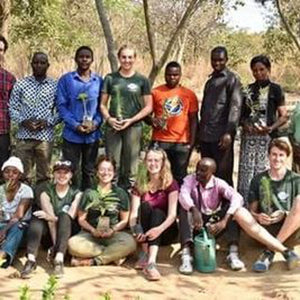
Serengeti ECO Protection and Development Alliance: Agroforestry, Sustainable Natural Resource Management and Livelihood Development
Serengeti ECO Protection and Development Alliance (SEPDA TANZANIA) works with farmers on an individual basis to determine their specific needs. While some farmers may want fruit trees dispersed on their land others may benefit from natural windbreaks and/or living fences, which incorporate hundreds of trees within a farm. Depending on the agroforestry system, some households can incorporate as many as 500 trees per acre. If a household is using their land for woodlots to produce firewood and construction materials, then 800 trees per acre can easily be accommodated.
Environmental education is a vital component of our program. We work in communities that desire changes and improvements and have a willingness to adapt new ways of co-existing with nature. We teach community leaders and locals how to manage surrounding woodlands so loss of habitat through deforestation and forest degradation will never become a problem. These communities require wood for fodder, fuel and construction materials, so we encourage farmers to plant multi-purpose, fast growing varieties of trees that fulfill these needs in a productive and non-destructive manner. We teach agro forestry techniques to local farmers so food can be produced without utilizing traditional slash and burn agriculture and the consequent clearing and degradation of numerous acres of land.
Incorporating well designed agroforestry practices into farming systems helps alleviate the pressure being exerted on existing natural resources, resulting in a sustainable and resilient ecosystem. An important distinction in our work is that the trees planted in our program belong not to us, but to the local community.
The Problem
Increases in human population in the project area regions have created a greater need for agricultural products which has led to increased conversion of healthy ecosystems to agriculture. Consequently, the area of usable land is declining for lack of measures to protect the fragile topsoil. Farmers have tried their best to increase production, while at the same time the fertility of their soils declines. In a country where 85% of the growing population relies primarily on agriculture to subsist, annual decreases in soil fertility and arable land proves devastating. Unfortunately more intensive farming practices, implemented unsustainably, further accelerates the decline in productivity through encouraging erosion.
The same increase in human population has caused large increases in livestock holdings since ownership of cattle, goats, sheep and other grazing animals are both an economic and a social necessity. More animals on the land has a compounding effect on the soil. These animals eat all available forage while at the same time compacting the soil under their weight so that vegetation, less unpalatable weeds, is no longer able to thrive. Moreover, since water is unable to penetrate the compacted, hardened and bare soil, it flows off into nearby streams and rivers carrying any nutrients left in the topsoil with it. The increase in livestock population and decrease in nutritious food and water has left animals too unhealthy to fight the diseases that affect them. Unable to afford the appropriate medications, the owners are having problems maintaining healthy livestock.
Another factor contributing to this growing disaster is that firewood and wood-based charcoal remains the primary energy source in the project area. The growing shortage of wood for fuel makes life especially difficult for women and children who can spend hours each day searching for trees and brush they can cut and carry to their...
The Solution
The goal of this project is to sustainably rehabilitate, protect and manage the natural resources and endangered species of Songwe and Mara regions while increasing the livelihood security and income generating capacity of project participants. This goal will be accomplished through meeting the following project objectives:
- Implementing a training program on agroforestry and sustainable land management practices to smallholder farmers and household heads (women and men), local development agents, and youth environmental clubs
- Enhancing soil health and conservation through the extension of agroforestry practices to be implemented in smallholder farmers’ fields and gardens.
- Mobilizing and assisting communities to plant trees that will restore health and productivity to degraded and over-used lands, while providing forage crops to discourage harmful grazing practices as well as fuel wood to discourage further deforestation.
- Assisting communities to reforest watersheds in order to prevent erosion and increase ground water volume and purity
- Training small-holder farmers on tree seedling production ( establish tree nurseries as demo sites) and seed production, collection and storage
- Managing 8 community tree nurseries for seedling production to be used for tree planting activities with main on fruit trees
Issues to be addressed;
- Windbreaks – erosion
- Living fences – erosion, compaction, overgrazing
- Sustainable fuelwood – natural resource degradation
- Increased food security through fruit trees planting
Project activities shall include;
- Training / education
- Nursery Raising
- Outplanting
- Monitoring and supervision
Since its inception in 2016 to August 2018 SEPDA TANZANIA have planted 11 million trees successfully by involving schools, churches, small environmental groups in 20 communities in Serengeti, Mwanza and Kagera regions focused on Agroforestry.
Planned Use Of Funds
Our organization is currently seeking funding for our ongoing projects in Songwe and Mara regions where we have a goal to plant 50 million trees by December 2019. Our goal is to rehabilitate and improve the productive potential of degraded and marginal lands, thereby improving the socio economic conditions of the participating communities. Our model is community-driven. We work primarily with farmers and community groups in marginalized areas, and full participation and ownership of the projects by those participants is considered crucial to the sustainability and success of our approach. We initially plant multi-purpose, fast-growing trees that lower daytime soil temperatures, provide partial shade, and add humus and nutrients to the soil. This creates a microclimate that allows dormant seeds and native trees to germinate and re-establish themselves, the first step to restore much of the past diversity.
Participating farmers will benefit from the incorporation of trees into agroforestry systems which will provide additional food, protection from the elements, and habitat while concurrently rejuvenating the soil. Fuel wood will be harvested from sustainable wood lots instead of nearby forests. An increased number of trees on farms and communal land will help us all breathe a littler easier. Greater provisions of nutritious foods will lead to an increase in overall population heath, as well as, a decrease in illnesses. Thousands would indirectly benefit from more available and affordable produce and firewood. All communities within the same watershed would benefit from cleaner streams and rivers due to lower levels of topsoil and silt accumulation in vital bodies of water. SEPDA’s programs continue to grow at a consistent rate, in terms of numbers of trees planted and the number of planting sites. Unfortunately, financial resources have not kept pace with the success of our programs. Their continuous growth demonstrates the successful model, but...
Stage of Development
- Early Stage
- Established Prototype
- Scaling
- Other
Organization to Receive Funds
Yes! Our goal is to rehabilitate and improve the productive potential of degraded and marginal lands, thereby improving the socio economic conditions of the participating communities. Our model is community-driven. We work primarily with farmers and community groups in marginalized areas, and full participation and ownership of the projects by those participants is considered crucial to the sustainability and success of our approach. We initially plant multi-purpose, fast-growing trees that lower daytime soil temperatures, provide partial shade, and add humus and nutrients to the soil. This creates a microclimate that allows dormant seeds and native trees to germinate and re-establish...




Join The Discussion